Soyuz 28
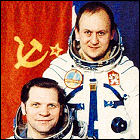 The Soviet Union launches the Soyuz 28 mission, the first manned flight in its Interkosmos series of international space missions. Cosmonaut Vladimír Remek is the first Czech in space, as well as the first space traveler not born in the Soviet Union or the United States; along with Soyuz 28 mission commander Alexei Gubarev, Remek visits the Salyut 6 space station for several days, though is presence is purely political showmanship; Remek later reveals that he had few actual functions to perform during the flight. Soyuz 28 spends a total of nearly eight days in space before returning to Earth.
The Soviet Union launches the Soyuz 28 mission, the first manned flight in its Interkosmos series of international space missions. Cosmonaut Vladimír Remek is the first Czech in space, as well as the first space traveler not born in the Soviet Union or the United States; along with Soyuz 28 mission commander Alexei Gubarev, Remek visits the Salyut 6 space station for several days, though is presence is purely political showmanship; Remek later reveals that he had few actual functions to perform during the flight. Soyuz 28 spends a total of nearly eight days in space before returning to Earth.
Progress 1
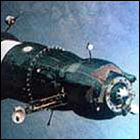 The first Soviet-made uncrewed Progress resupply vehicle lifts off en route to the manned Salyut 6 space station. Looking more or less like a Soyuz vehicle, Progress is an automated freighter whose systems lock onto Salyut’s docking transponder, guiding the unmanned craft toward a smooth and completely automated docking (though ground controllers stand by to take manual control by remote). Since Progress is not required to return a crew to Earth, its engines and their fuel can help to boost Salyut 6 into a higher orbit when necessary. It carries over 5,000 pounds of food, clothes and other supplies, and can automatically refill the station’s air and fuel supplies. Progress vehicles become an integral part of the space program, remaining in service long enough to resupply the International Space Station in the 21st century.
The first Soviet-made uncrewed Progress resupply vehicle lifts off en route to the manned Salyut 6 space station. Looking more or less like a Soyuz vehicle, Progress is an automated freighter whose systems lock onto Salyut’s docking transponder, guiding the unmanned craft toward a smooth and completely automated docking (though ground controllers stand by to take manual control by remote). Since Progress is not required to return a crew to Earth, its engines and their fuel can help to boost Salyut 6 into a higher orbit when necessary. It carries over 5,000 pounds of food, clothes and other supplies, and can automatically refill the station’s air and fuel supplies. Progress vehicles become an integral part of the space program, remaining in service long enough to resupply the International Space Station in the 21st century.
Soyuz 27
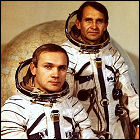 The Soviet Union launches Soyuz 27 on a mission to the Salyut 6 space station – the first instance of three vehicles being docked together in space. Cosmonauts Vladimir Dzhanibekov and Oleg Makarov spend six days with the crew of Soyuz 26 board the station, although Dzhanibekov and Makarov swap capsules with the station crew, leaving the newer vehicle at the station for their eventual return. The crew of Soyuz 27 is in space for less than a week, but their spacecraft remains in orbit, connected to Salyut, for over two months.
The Soviet Union launches Soyuz 27 on a mission to the Salyut 6 space station – the first instance of three vehicles being docked together in space. Cosmonauts Vladimir Dzhanibekov and Oleg Makarov spend six days with the crew of Soyuz 26 board the station, although Dzhanibekov and Makarov swap capsules with the station crew, leaving the newer vehicle at the station for their eventual return. The crew of Soyuz 27 is in space for less than a week, but their spacecraft remains in orbit, connected to Salyut, for over two months.
Soyuz 26
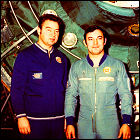 A two-man crew – cosmonauts Yuri Romanenko and Georgi Grechko – is launched aboard Soyuz 26 by the Soviet Union. The Soyuz capsule docks with the recently-launched Salyut 6 space station, and the crew takes up residence for over three months, setting a new space endurance record at 96 days. The Soyuz 27 crew visits in January and swaps vehicles with the station occupants, meaning that Romanenko and Grechko technically return to Earth aboard Soyuz 27 in March 1978. Ten days into the mission, the first Soviet spacewalk since 1969 is undertaken to examine the forward docking hatch of Salyut 6, with which the previous mission failed to connect. This spacewalk was the first outing of the Soviet-made Orlan spacesuit, a design still in use on the International Space Station in the 21st century.
A two-man crew – cosmonauts Yuri Romanenko and Georgi Grechko – is launched aboard Soyuz 26 by the Soviet Union. The Soyuz capsule docks with the recently-launched Salyut 6 space station, and the crew takes up residence for over three months, setting a new space endurance record at 96 days. The Soyuz 27 crew visits in January and swaps vehicles with the station occupants, meaning that Romanenko and Grechko technically return to Earth aboard Soyuz 27 in March 1978. Ten days into the mission, the first Soviet spacewalk since 1969 is undertaken to examine the forward docking hatch of Salyut 6, with which the previous mission failed to connect. This spacewalk was the first outing of the Soviet-made Orlan spacesuit, a design still in use on the International Space Station in the 21st century.
Soyuz 25
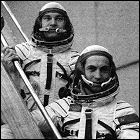 The Soviet Union launches Soyuz 25 into Earth orbit, with cosmonauts Vladimir Kovalyonok and Valery Ryumin set to become the first occupants of the new Salyut 6 space station. However, the crew is unable to successfully dock Soyuz 25 to Salyut 6, and after a fifth attempt to dock, the mission is aborted and the cosmonauts are recalled to Earth due to concerns about the remaining fuel in their vehicle. As a result, Soyuz 25 is the last all-rookie Soviet space crew until the 1990s.
The Soviet Union launches Soyuz 25 into Earth orbit, with cosmonauts Vladimir Kovalyonok and Valery Ryumin set to become the first occupants of the new Salyut 6 space station. However, the crew is unable to successfully dock Soyuz 25 to Salyut 6, and after a fifth attempt to dock, the mission is aborted and the cosmonauts are recalled to Earth due to concerns about the remaining fuel in their vehicle. As a result, Soyuz 25 is the last all-rookie Soviet space crew until the 1990s.
Salyut 6
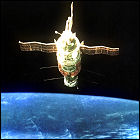 The Soviet Union launches the redesigned Salyut 6 space station, which will remain in service for five years. With six years of experience in building and operating space stations, Soviet space engineers embark on a rethink of station construction, opting for a more modular approach with Salyut 6: the new station has docking ports fore and aft, with additional station modules and automated resupply vehicles already on the drawing board. The dual docking ports also allow for multiple Soyuz capsules to be berthed at Salyut 6, making larger crews possible.
The Soviet Union launches the redesigned Salyut 6 space station, which will remain in service for five years. With six years of experience in building and operating space stations, Soviet space engineers embark on a rethink of station construction, opting for a more modular approach with Salyut 6: the new station has docking ports fore and aft, with additional station modules and automated resupply vehicles already on the drawing board. The dual docking ports also allow for multiple Soyuz capsules to be berthed at Salyut 6, making larger crews possible.
Salyut 5 burns up
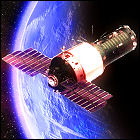 The Soviet-launched Salyut 5 military space station tumbles out of its orbit, having exhausted the fuel needed to keep it in a controlled orbit of the Earth. The two-ton space station burns up on re-entry, having been visited by only two crews; another mission to Salyut 5 had been planned, but its fuel depletion made that flight too risky to undertake.
The Soviet-launched Salyut 5 military space station tumbles out of its orbit, having exhausted the fuel needed to keep it in a controlled orbit of the Earth. The two-ton space station burns up on re-entry, having been visited by only two crews; another mission to Salyut 5 had been planned, but its fuel depletion made that flight too risky to undertake.
Space Cooperation Agreement renewed
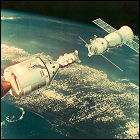 With the 1972 agreement having resulted in the successful Apollo-Soyuz Test Project, the United States and the Soviet Union formally renew the Space Cooperation Agreement. As an immediate goal to build on Apollo-Soyuz, both countries hold tentative discussions about docking the American Space Shuttle (which, it is still assumed, will be in space before the 1970s are out) and a Soviet Salyut space station. Though the shuttle’s first flight is still being delayed, the biggest hurdle will prove to be international relations, specifically a renewed chilling of the Cold War thanks to the Soviet Union’s 1979 invasion of Afghanistan.
With the 1972 agreement having resulted in the successful Apollo-Soyuz Test Project, the United States and the Soviet Union formally renew the Space Cooperation Agreement. As an immediate goal to build on Apollo-Soyuz, both countries hold tentative discussions about docking the American Space Shuttle (which, it is still assumed, will be in space before the 1970s are out) and a Soviet Salyut space station. Though the shuttle’s first flight is still being delayed, the biggest hurdle will prove to be international relations, specifically a renewed chilling of the Cold War thanks to the Soviet Union’s 1979 invasion of Afghanistan.
Soyuz 24
 The Soviet Union launches the Soyuz 24 mission to the Salyut 5 military space station. Cosmonauts Viktor Gorbatko and Yuri Glazkov carry special breathing gear to protect them from toxic fumes reported to have been the cause of the hasty exit of the crew of Soyuz 21 in 1976. They vent the entire atmosphere of Salyut 5 into space and replenish it, taking up residence for 18 days, during which they perform their own science and Earth surveillance experiments. They leave the station habitable for a visit by another crew, but Salyut 5’s fuel will be exhausted before that mission can take place.
The Soviet Union launches the Soyuz 24 mission to the Salyut 5 military space station. Cosmonauts Viktor Gorbatko and Yuri Glazkov carry special breathing gear to protect them from toxic fumes reported to have been the cause of the hasty exit of the crew of Soyuz 21 in 1976. They vent the entire atmosphere of Salyut 5 into space and replenish it, taking up residence for 18 days, during which they perform their own science and Earth surveillance experiments. They leave the station habitable for a visit by another crew, but Salyut 5’s fuel will be exhausted before that mission can take place.
Abandon ship!: Soyuz 21’s hasty return
 42 days into their stay aboard the military space station Salyut 5, Soviet cosmonauts Boris Volynov and Vitaly Zholobov report unusual odors in the station’s air. On the 49th day of their stay, the two men bundle into their Soyuz 21 capsule to return home on only 10 hours’ notice, an unprecedented event. Details of the causes of the emergency return remain closely guarded to this day, including the possibility of toxic gas escaping into the station’s atmosphere and causing one or both cosmonauts to suffer rapidly deteriorating health. Neither of them fly in space again after their return.
42 days into their stay aboard the military space station Salyut 5, Soviet cosmonauts Boris Volynov and Vitaly Zholobov report unusual odors in the station’s air. On the 49th day of their stay, the two men bundle into their Soyuz 21 capsule to return home on only 10 hours’ notice, an unprecedented event. Details of the causes of the emergency return remain closely guarded to this day, including the possibility of toxic gas escaping into the station’s atmosphere and causing one or both cosmonauts to suffer rapidly deteriorating health. Neither of them fly in space again after their return.
Soyuz 21
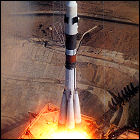 The Soviet Union launches cosmonauts Boris Volynov and Vitaly Zholobov aboard Soyuz 21, the first mission to the newly-orbited Salyut 5 military space station. Though a few scientific experiments are conducted, most of the crew’s activities involve military surveillance of Earth. The crew’s stay is intended to last as long as two months, though an emergency aboard the station will cut that stay short.
The Soviet Union launches cosmonauts Boris Volynov and Vitaly Zholobov aboard Soyuz 21, the first mission to the newly-orbited Salyut 5 military space station. Though a few scientific experiments are conducted, most of the crew’s activities involve military surveillance of Earth. The crew’s stay is intended to last as long as two months, though an emergency aboard the station will cut that stay short.
Salyut 5
 The Soviet Union launches the two-ton Salyut 5 space station into Earth orbit. Salyut 5 is the final Soviet space station to utilize the Almaz military station architecture originally specified in the 1960s (at which time Almaz was developed to counter the perceived threat from the never-launched American Manned Orbiting Laboratory). The station carries Earth surveillance equipment and a return capsule for later retrieval of experiments and film. Salyut 5 remains in orbit for a little over a year, visited by only two crews.
The Soviet Union launches the two-ton Salyut 5 space station into Earth orbit. Salyut 5 is the final Soviet space station to utilize the Almaz military station architecture originally specified in the 1960s (at which time Almaz was developed to counter the perceived threat from the never-launched American Manned Orbiting Laboratory). The station carries Earth surveillance equipment and a return capsule for later retrieval of experiments and film. Salyut 5 remains in orbit for a little over a year, visited by only two crews.
Soyuz 18
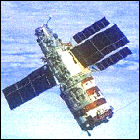 Soyuz 18 is launched toward space station Salyut 4 by the Soviet Union. Cosmonauts Pyotr Klimuk and Vitali Sevastyanov set a new Soviet record for long-duration stays in space, remaining about Salyut 4 for two months. They are also aboard Salyut 4 during the entirety of the Apollo-Soyuz Test Project, and are able to contact that international mission’s Soviet crew in another Soyuz vehicle. (Two mission control centers are used to prevent any confusion between the two Soyuz crews.) At the time the Soyuz 18 crew abandons Salyut 4 in July, the station’s environmental systems are failing, allowing the atmosphere inside the station to become humid enough for mold to begin growing on surfaces in the crew compartment; no further human crews will visit the station.
Soyuz 18 is launched toward space station Salyut 4 by the Soviet Union. Cosmonauts Pyotr Klimuk and Vitali Sevastyanov set a new Soviet record for long-duration stays in space, remaining about Salyut 4 for two months. They are also aboard Salyut 4 during the entirety of the Apollo-Soyuz Test Project, and are able to contact that international mission’s Soviet crew in another Soyuz vehicle. (Two mission control centers are used to prevent any confusion between the two Soyuz crews.) At the time the Soyuz 18 crew abandons Salyut 4 in July, the station’s environmental systems are failing, allowing the atmosphere inside the station to become humid enough for mold to begin growing on surfaces in the crew compartment; no further human crews will visit the station.
Salyut 3: first weapon fired in space
 One day before deorbiting the vacant space station for reentry into Earth’s atmosphere, Soviet military space officials fire the anti-aircraft cannon mounted on the exterior of space station Salyut 3 – the first test of spacecraft-to-spacecraft weapons in history (though there is no target on which to test the ammunition rounds). Without a steerable mount, in practice, the entire Salyut 3 station would need to have been pointed at the gun’s target. The station is destroyed by friction upon atmospheric reentry a day later.
One day before deorbiting the vacant space station for reentry into Earth’s atmosphere, Soviet military space officials fire the anti-aircraft cannon mounted on the exterior of space station Salyut 3 – the first test of spacecraft-to-spacecraft weapons in history (though there is no target on which to test the ammunition rounds). Without a steerable mount, in practice, the entire Salyut 3 station would need to have been pointed at the gun’s target. The station is destroyed by friction upon atmospheric reentry a day later.
Soyuz 17
 Soyuz 17 is launched by the Soviet Union, carring cosmonauts Alexei Gubarev and Georgi Grechko to the Salyut 4 space station. The two men move into the station for a month-long stay, breaking the previous Soviet space record, and proceed to conduct several science experiments. Discovering that the mirror of Salyut 4’s on-board telescope is warped, the crew resurfaces it in orbit and repairs the telescope. When Soyuz 17 returns to Earth, the crew is in for one of the bumpiest landings of the Soviet space program to date, landing in a blizzard with 45mph winds at ground level. Despite this, the vehicle lands safely and the crew is not injured.
Soyuz 17 is launched by the Soviet Union, carring cosmonauts Alexei Gubarev and Georgi Grechko to the Salyut 4 space station. The two men move into the station for a month-long stay, breaking the previous Soviet space record, and proceed to conduct several science experiments. Discovering that the mirror of Salyut 4’s on-board telescope is warped, the crew resurfaces it in orbit and repairs the telescope. When Soyuz 17 returns to Earth, the crew is in for one of the bumpiest landings of the Soviet space program to date, landing in a blizzard with 45mph winds at ground level. Despite this, the vehicle lands safely and the crew is not injured.
Salyut 4
 The Soviet Union launches its fourth orbital space station, Salyut 4. Much like Skylab, Salyut 4 is fitted with a solar telescope and X-ray astronomy equipment, which is trained on the X-ray source (and potential black hole) Cygnus X-1 during its flight. Three crews will go on to occupy Salyut 4 before it is deorbited in 1977; it is the first Soviet space station to successfully be occupied by multiple crews.
The Soviet Union launches its fourth orbital space station, Salyut 4. Much like Skylab, Salyut 4 is fitted with a solar telescope and X-ray astronomy equipment, which is trained on the X-ray source (and potential black hole) Cygnus X-1 during its flight. Three crews will go on to occupy Salyut 4 before it is deorbited in 1977; it is the first Soviet space station to successfully be occupied by multiple crews.
Soyuz 15
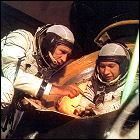 The Soviet space program continues with the launch of Soyuz 15, carrying cosmonauts Lev Dyomin and Gennadi Sarafanov. This is intended to be the second crew to occupy the Salyut 3 military space station, but spacecraft systems intended to automate the rendezvous and docking process fail. After manual dockings are attempted, the Soyuz vehicle is running low on fuel and the crew is recalled to Earth after only two days. (Trying to dodge questions about the nature of Salyut 3’s mission objectives, Soviet space authorities later claim that Soyuz 15 was never going to dock with the station.) No further crews are sent to board Salyut 3.
The Soviet space program continues with the launch of Soyuz 15, carrying cosmonauts Lev Dyomin and Gennadi Sarafanov. This is intended to be the second crew to occupy the Salyut 3 military space station, but spacecraft systems intended to automate the rendezvous and docking process fail. After manual dockings are attempted, the Soyuz vehicle is running low on fuel and the crew is recalled to Earth after only two days. (Trying to dodge questions about the nature of Salyut 3’s mission objectives, Soviet space authorities later claim that Soyuz 15 was never going to dock with the station.) No further crews are sent to board Salyut 3.
Soyuz 14
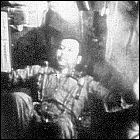 The Soviet Union launches the Soyuz 14 mission, sending cosmonauts Yuri Artyukhin and Pavel Popovich to embark on a two-week stay aboard the Salyut 3 military space station. Though some medical science experiments are performed at Salyut 3, the majority of the crew’s time is taken up with observations of the Earth’s surface, essentially making Salyut 3 the first manned military surveillance satellite. Before leaving, the crew of two offloads supplies so that the new Salyut 3 crew can stay for several months.
The Soviet Union launches the Soyuz 14 mission, sending cosmonauts Yuri Artyukhin and Pavel Popovich to embark on a two-week stay aboard the Salyut 3 military space station. Though some medical science experiments are performed at Salyut 3, the majority of the crew’s time is taken up with observations of the Earth’s surface, essentially making Salyut 3 the first manned military surveillance satellite. Before leaving, the crew of two offloads supplies so that the new Salyut 3 crew can stay for several months.
Salyut 3: packin’ heat in orbit
 The Soviet Union launches its third space station, again based on the Almaz military space station architecture. Salyut 3 remains in orbit for over half a year, and is eventually visited by the crews of Soyuz 14 and Soyuz 15, though the latter mission fails to dock. Despite international agreements already in place to prevent the militarization of space, Salyut 3 is the first armed space station, packing a non-steerable anti-aircraft gun (for defending the station, though from what is never made clear). Fortunately, the space war never happens and Salyut 3 is never forced to defend itself.
The Soviet Union launches its third space station, again based on the Almaz military space station architecture. Salyut 3 remains in orbit for over half a year, and is eventually visited by the crews of Soyuz 14 and Soyuz 15, though the latter mission fails to dock. Despite international agreements already in place to prevent the militarization of space, Salyut 3 is the first armed space station, packing a non-steerable anti-aircraft gun (for defending the station, though from what is never made clear). Fortunately, the space war never happens and Salyut 3 is never forced to defend itself.
Salyut 2: first military space station
 The Soviet Union launches a second space station, and the first station designed exclusively for military tasks in orbit. Salyut 2 is the first station to use the Almaz military space station design devised in the 1960s as a response to the US Air Force’s never-flown Manned Orbiting Laboratory. Within two weeks, however, technical difficulties take their toll: Salyut 2 begins to tumble out of control, and its crew compartment depressurizes. (The redesigned Soyuz vehicle is not ready to fly yet, so no crew ever visits Salyut 2.) The second Soviet space station burns up in the atmosphere less than two months after launch.
The Soviet Union launches a second space station, and the first station designed exclusively for military tasks in orbit. Salyut 2 is the first station to use the Almaz military space station design devised in the 1960s as a response to the US Air Force’s never-flown Manned Orbiting Laboratory. Within two weeks, however, technical difficulties take their toll: Salyut 2 begins to tumble out of control, and its crew compartment depressurizes. (The redesigned Soyuz vehicle is not ready to fly yet, so no crew ever visits Salyut 2.) The second Soviet space station burns up in the atmosphere less than two months after launch.
An international space station?
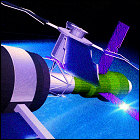 With planning already well underway for the Apollo-Soyuz mission which won’t take place until 1975, NASA commissions a study from McDonnell Douglas to explore the feasibility of a follow-up to the international space mission, possibly involving joining the backup of the Skylab space station (known as “Skylab B”) and a yet-to-be-launched Soviet Salyut space station at some point in the latter half of the 1970s, effectively creating a joint international space station. Although the study goes so far as to specify issues of concern regarding the structure of the two stations and their respective standard atmospheric pressures, the recommendations are shelved pending the outcome of the Apollo-Soyuz flight. Significant political developments in the late 1970s will prevent the idea of an international station from moving forward for at least a quarter century.
With planning already well underway for the Apollo-Soyuz mission which won’t take place until 1975, NASA commissions a study from McDonnell Douglas to explore the feasibility of a follow-up to the international space mission, possibly involving joining the backup of the Skylab space station (known as “Skylab B”) and a yet-to-be-launched Soviet Salyut space station at some point in the latter half of the 1970s, effectively creating a joint international space station. Although the study goes so far as to specify issues of concern regarding the structure of the two stations and their respective standard atmospheric pressures, the recommendations are shelved pending the outcome of the Apollo-Soyuz flight. Significant political developments in the late 1970s will prevent the idea of an international station from moving forward for at least a quarter century.
Salyut 1 down
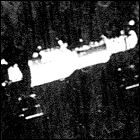 With its first crew having perished, prompting a far-reaching reorganization of the Soviet space program and its technology, the now-unmanned Salyut 1 space station is ordered to fire its thrusters, slowing it down to re-enter Earth’s atmosphere over the Pacific Ocean. With no immediate prospect of a new crew to inhabit it, the first space station intended for long-term occupation by a human crew barely lasts six months in orbit.
With its first crew having perished, prompting a far-reaching reorganization of the Soviet space program and its technology, the now-unmanned Salyut 1 space station is ordered to fire its thrusters, slowing it down to re-enter Earth’s atmosphere over the Pacific Ocean. With no immediate prospect of a new crew to inhabit it, the first space station intended for long-term occupation by a human crew barely lasts six months in orbit.
Soyuz 11
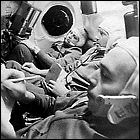 After a tuberculosis scare forces Soviet space officials to ground the mission’s original crew, the backup crew of Soyuz 11 lifts off to become the first occupants of a manned space station. Experiencing none of the difficulties that plagued the earlier Soyuz 10 attempt to dock with Salyut 1, the Soyuz 11 crew stays aboard Salyut for 22 days, a new record for a manned space mission.
After a tuberculosis scare forces Soviet space officials to ground the mission’s original crew, the backup crew of Soyuz 11 lifts off to become the first occupants of a manned space station. Experiencing none of the difficulties that plagued the earlier Soyuz 10 attempt to dock with Salyut 1, the Soyuz 11 crew stays aboard Salyut for 22 days, a new record for a manned space mission.
Soyuz 10: technical difficulties
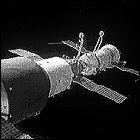 The Soviet Union launches the Soyuz 10 mission, intended to become the first crew to occupy an Earth-orbiting space station. Flying a new modification of the Soyuz vehicle, fitted with a new system for docking to the Salyut 1 space station, are Vladimir Shatalov, Alexei Yeliseyev and Nikolai Rukavishnikov, but they won’t be the first space station crew in history: the Soyuz capsule fails to hard-dock to the station, making it impossible for them to enter. Soyuz 10 returns to Earth after two days, and even on the return journey the cosmonauts are sickened by toxic fumes in their environmental system. Salyut 1 remains in orbit, still unmanned.
The Soviet Union launches the Soyuz 10 mission, intended to become the first crew to occupy an Earth-orbiting space station. Flying a new modification of the Soyuz vehicle, fitted with a new system for docking to the Salyut 1 space station, are Vladimir Shatalov, Alexei Yeliseyev and Nikolai Rukavishnikov, but they won’t be the first space station crew in history: the Soyuz capsule fails to hard-dock to the station, making it impossible for them to enter. Soyuz 10 returns to Earth after two days, and even on the return journey the cosmonauts are sickened by toxic fumes in their environmental system. Salyut 1 remains in orbit, still unmanned.
Salyut 1: the first space station
 Salyut 1, the first orbiting space station in history is launched, unmanned, by the Soviet Union. With Salyut 1, the Soviet space program intends to vault ahead of the United States in a new space discipline (namely long stays in space and the study of human endurance in a zero-G environment), having lost the moon race. The first Salyut station will orbit Earth for less than a year.
Salyut 1, the first orbiting space station in history is launched, unmanned, by the Soviet Union. With Salyut 1, the Soviet space program intends to vault ahead of the United States in a new space discipline (namely long stays in space and the study of human endurance in a zero-G environment), having lost the moon race. The first Salyut station will orbit Earth for less than a year.